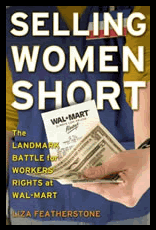Equal Rights and Opportunity in the Labor Force
- Key Victories -
Main | Entering the Workforce | Careerism | Fighting Sexual Discrimination | Key Victories | Additional Resources | Glossary
Sexual Discrimination and the Law
 |
Over the years, women have successfully challenged the social and institutional norms our society, to establish a more equal playing field between the two genders. Through employing different forms of legislation, as discussed on the the Fighting Sexual Discrimination page, women were able to set important precedents that help us continue to fight for equal rights and opportunities in the labor force. |
Equal Pay
Allison Schieffelin against Morgan Stanley
|
|
Once Ms. Schieffelin revealed her intention to file for discrimination with the EEOC, Ms. Schieffelin further alleges that Morgan Stanley responded negatively against her by reducing her responsibilities, took away projects that she had worked on for years, ostracized and humiliated her, and subsequently fired her on pretextual grounds. This case was brought to court and was ruled with a $54 million dollar settlement, setting a huge precedent against discrimination in respected white-collared jobs. In agreeing to pay for the settlement, Morgan Stanley in essence, admitting that such events did take place and further serves as an example to other firms.
Allstate Insurance
Like many of the female employees today, Lola Kouba discovered that she was earning less than her male coworkers, who had the same job and comparable qualifications as she, while working at Allstate Insurance Company. Furthermore, because Allstate determines its employees' wages based on prior salaries, women on average were paid less than men.[3] Because women traditionally earn less than men, Allstate women employees' salaries essentially started a notch or two lower on the wage ladder than their male co-workers. Kouba's case was taken to court, and was awarded a settlement of $5 million for 3,400 women nationwide in the struggle towards women's equality - helping to close the wage gap that exists between men and women.
Equal Opportunity
Women against Wal-Mart
|
Similar to the Morgan and Stanley case, women are fighting to ensure equal rights and opportunities in blue-collared jobs, as exemplified through the current lawsuit against Wal-Mart. Though Wal-Mart is the nation's biggest company and the largest private employer, a recent study reveals that "women comprise 66% of Wal-Mart's hourly employees but only 33% of the salaried managers, and just 14% of store managers."[4] Six current and former female Wal-Mart and Sam's Club employees filed a class action lawsuit against Wal-Mart alleging that Wal-Mart discriminates "against its female employees in making promotions, job assignments, pay decisions and training, and retaliates against women who complain against such practices."[5] Such efforts to exclude women from upper level managerial jobs are being challenged by these women through the EEOC and is still awaiting a court decision. In the meantime, the Wal-Mart Class is calling women to voice out their concerns and join in fighting against these inequalities.[6] Please refer to the Additional Resources page further information. A positive ruling in this case would result in substantial structural changes in the multi-million dollar firm and would serve as a strong example of corporate firm accountability. |
San Francisco
Up until 1978, women in the city of San Francisco were explicitly denied the right to become firefighters. With the help of Equal Rights Advocates these policies were challenged and reversed by 1987 with the admittance of the department's first female firefighter. In 1984, Equal Rights Advocates and its counsel sued the San Francisco Fire Department for discrimination in its hiring and promotion policies, and by 1996, the department's first two female captains were also appointed.[7] Presently, San Francisco has one of the highest percentages of women firefighters at around 12 percent - truly demonstrating that San Francisco has come a long way from once being the only major city in the country without even one female firefighter.
The U.S. Forest Service
The U.S. Forest Service, which is an agency of the U.S. Department of Agriculture, has historically been male-dominated even from its establishment in 1905.[8] Similar to the case above, the Equal Rights Advocates filed a class action suit against the agency for its discriminatory placement and promotion practices. After an 18 year legal battle, by 1992, the percentage of women in professional job categories increased from 12% to 37%, in administrative job categories from 32% to 68%, and in technical job categories from 18% to 34%.[9] As a result of Equal Opportunity Feminism, the U.S. Forest Service is now hiring and promoting a significantly higher number of women.
Fighting Sexual Harassment at Work
San Francisco Police
In order to maintain the peace and to fit in at work as "one of the guys," Louette Colombano persevered through nine years of sexual harassment as a police office in the San Francisco area. Though she rarely said anything about her own personal experiences, upon witnessing illicit and illegal behavior at a San Francisco Police Department Party she went directly to the press. At the party, a prostitute was hired to have sex with a rookie cop - the final straw of her negative experiences while working there. For breaking the police code of silence, Colombano suffered a vicious campaign of retaliation by the department and was eventually forced to leave. After taking this case to court, Colombano won a settlement of about $800,000. [10]
Glass Ceiling
Though there have been significant and substantial gains made by women through Equal Opportunity Feminism, women still have yet to achieve complete equality in the labor market. Compared to the societal expectations and perception of females in the workplace, women have come quite a distance. It is no longer an unusual phenomenon for married women to participate in the labor force, nor is it strange to see women employed in more male-dominated professions, such as construction. At the same time, there is still a significant lack of women in the upper echelons of the labor force. As Blau, Ferber and Winkler report, a study by Catalyst on Fortune 500 companies revealed women were sparsely represented on corporate boards of directors at 13.9 percent, while only "15.7 percent of all corporate officers and 7.9 percent of top-level executives were women in 2002."[11] They also report that in a sample of the five highest paid executives among a large group of firms, the study found only 2.5 percent of executives were women and that they earned 45 percent less than their male counterparts.
Women are strongly disadvantaged in the labor market because it is still very much a patriarchical institution. Women are relative newcomers to higher level jobs in the paid labor market, and need more time to move through the ranks to establish solid networks of support for other women. Many businessmen use personal contacts from the "old boys network" in a comfortably male workplace culture, where business is often conducted over playing golf and smoking cigars. At the same time, women as a gendered class, are still less geographically mobile as men, and still have to work against society's perception of women as primary family caretakers.
A study carried out by Catherine Weinberger regarding recent college graduates, reveals that women continue to have a wage disadvantage compared to men. Even after holding education, qualifications and experience, women of different ethnic backgrounds constant, "all face the same 10 to 15 percent wage disadvantage relative to white men with the same type and quality of college education." [12] Therefore, despite the great gains that our generation has seen in establishing increasingly equitable opportunities within the labor force, there is still a continued prevalence of the "glass ceiling" women are limited by. This is precisely the reason why there is still a need for Equal Opportunity Feminism to continue to push for equal rights and opportunities within the workplace.
References
[1] Morgan Stanley Sex Discrimination, 18 May 2007 <http://www.sexdiscriminationagainstmorganstanley.com>.
[2]Discrimination at Morgan Stanley, "Gender Discrimination at Morgan Stanley - EEOC Law Suit," 18 May 2007 <http://www.kamalsinha.com/morganstanley/gender-discrimination>.
[3] EqualRightsAdvocates.com, "Closing the Wage Gap," 20 May 2007 <http://www.equalrights.org/about/cases.asp>
[4] CNNMoney.com, "Women vs. Wal-Mart How can the retailer reconcile its storied culture with the anger of these female workers?,"
18 May 2007 < http://money.cnn.com/magazines/fortune/fortune_archive/2003/07/21/346130/index.htm >.
[5] Wal-Mart Class Website, "Walmart Class," <http://www.walmartclass.com/public_home.html>.
[6] Wal-Mart Class Website, "Frequently Asked Questions ," <http://www.walmartclass.com/all_faqs_index.html?websys_id=>.
[7] EqualRightsAdvocates.com, "Opening the Door to Equal Opportunities,"20 May 2007 <http://www.equalrights.org/about/cases.asp>.
[8][9] Ibid., <http://www.equalrights.org/about/cases.asp>.
[10] EqualRightsAdvocates.com, "Fighting Sexual Harassment at Work and School,"20 May 2007 <http://www.equalrights.org/about/cases.asp>.
[11] Blau, Francine D., Marianne A. Ferber, and Anne E. Winkler. The Economics of Women, Men, and Work. 5th ed. Upper Saddle Riber, NJ: Pearson Prentice Hall, 2006. 214.
[12] Weinberger, Catherine, "Race and Gender Wage Gaps in the Market for Recent College Graduates," Women and the Economy: A Reader, ed. Ellen Mutari and Deborah M. Figart. Armonk: M.E. Sharpe, 2003. pg. 173.
- Table of Contents -


